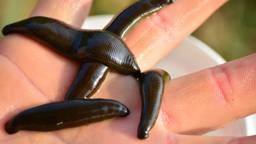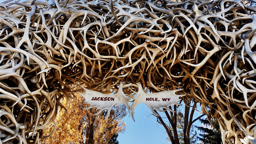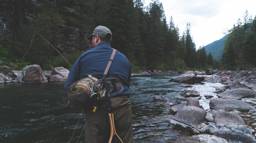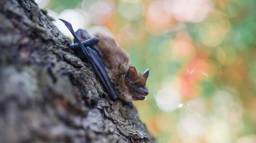Q: Our place is in northwestern Wisconsin. I took this photo of an animal on our property. Is it a wolf or coyote? Generally, how can a person differentiate between the two?
– Maggie Toms, Foxboro, Wis.
A: This is a very common question in cabin country. Thankfully, there are ways to tell which is which. Check any field guide, and you will learn that coyotes are small, weighing around 25 to 40 pounds, while a mature wolf ranges from 70 to 100 pounds. That information isn’t as helpful as one might expect in the heat of the moment, when adrenaline is working hard to leave a permanent impression on the observer’s memory. Besides, the difference in perceived size between a large coyote and a young wolf is minimal. To get positive identification, it is important to capture a few bits of evidence in your memory.
Tracks: If conditions are good, tracks will give you the best evidence for identity. Snow, mud, and sandy gravel roads may give you an opportunity to measure the tracks and even report the information to local wildlife officials when the excitement is over. An adult wolf track is approximately 4½ inches long, with the claws of all four toes facing deliberately forward, and the middle two toes clearly ahead of the outer toes. Look at your palm; a wolf track would practically cover it. When I’ve seen wolves, I have always been impressed by the size of their big, furry feet. By contrast, a coyote track forms a tight diamond shape and will be a maximum of 2¾ inches long. This track would fit in the shadow of your computer’s mouse. Following suit, I have always noticed how dainty the feet of a coyote appear.
Tail: Although somewhat variable, wolves tend to run with their tails held up away from their legs. By contrast, most coyotes keep their tails low along their legs. I’ve observed even unalarmed coyotes trotting along deer trails while keeping their tails in close. When on the run, wolves give an impression of power, running with tails somewhat aloft and each leg working independently to produce powerful loping. Coyotes often give the impression of delicacy, tucking the tail and dancing lightly with all legs involved together in light bounding.
Build: Wolves are very tall and proportionately rail thin. A side profile gives the impression of enormous size. Head on, however, a wolf is a thin-hipped animal with a big, blocky head. In short, wolves appear deer-tall with long legs. From nose to tail, a wolf is 5–6 feet long. Coyotes are usually 3–4 feet in length. Coyotes are not nearly so proportionately tall, and a coyote with a fine coat may even give the impression of having short legs as the luxurious fur covers the upper half of each leg.
Body proportions: In general, wolves and coyotes have the same sized ears and tails – not proportionately to each animal but in actual, measurable size. Those “same” ears and tails would look bigger on a small animal and smaller on a large animal. If the ears of your unidentified animal looked small and the tail looked somewhat short, it was probably a wolf. If the ears looked very tall and the tail looked luxuriously long, it was probably a coyote.
Color: Usually, wolves have an overall gray coat with long, blackened guard hairs running along the back and tail. Very often, the gray is complemented by some cream colors along the ribs and flanks, and the legs tend to be gray, white or cream colored. In wolves, cinnamon red colors are usually reserved for the backs of the ears. By contrast, coyotes are very cinnamon in color throughout, with no impression of long, black guard hairs. The legs tend to be more cinnamon in color as well.
In a nutshell, wolves give an impression of size and power. They have smallish ears on big, muscular heads, long legs, and an overall gray and pale coloration. Even a young wolf appears to have a muscular head and short tail. Coyotes give an impression of dainty frailty and have gray coats adorned with cinnamon red, which is a very detailed and lengthy way to say: That’s a coyote.
Brian M. Collins has been fortunate enough to observe more than 15 wild wolves and countless coyotes in Wisconsin and Minnesota since 1997. Both species make him very happy to be in the wild! 

 Maggie Toms
Maggie Toms 









